Module 5 Cartoon stories Unit 3 Language in use 教学课件(共69张PPT)
文档属性
| 名称 | Module 5 Cartoon stories Unit 3 Language in use 教学课件(共69张PPT) | 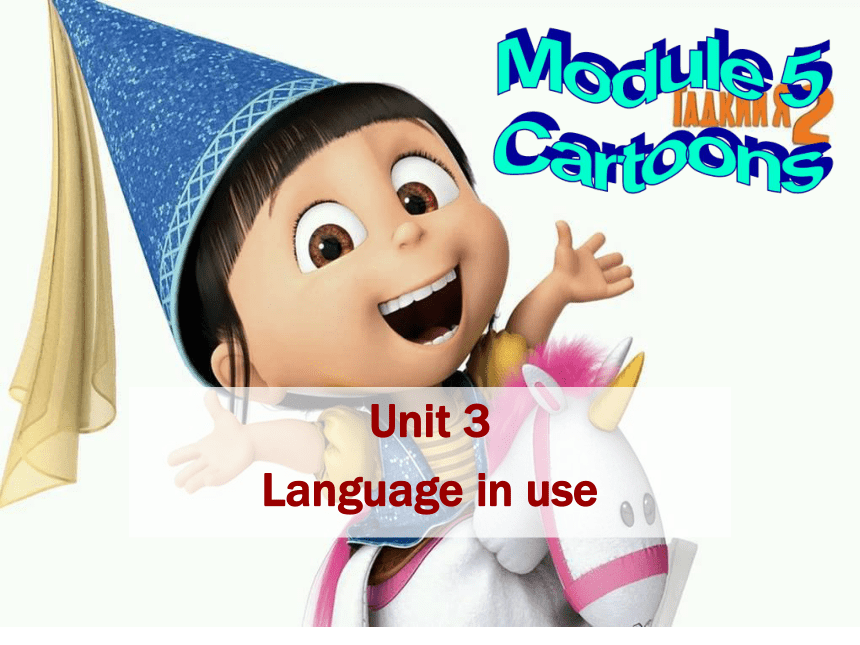 | |
| 格式 | zip | ||
| 文件大小 | 3.7MB | ||
| 资源类型 | 教案 | ||
| 版本资源 | 外研版 | ||
| 科目 | 英语 | ||
| 更新时间 | 2017-08-12 17:07:10 | ||
图片预览




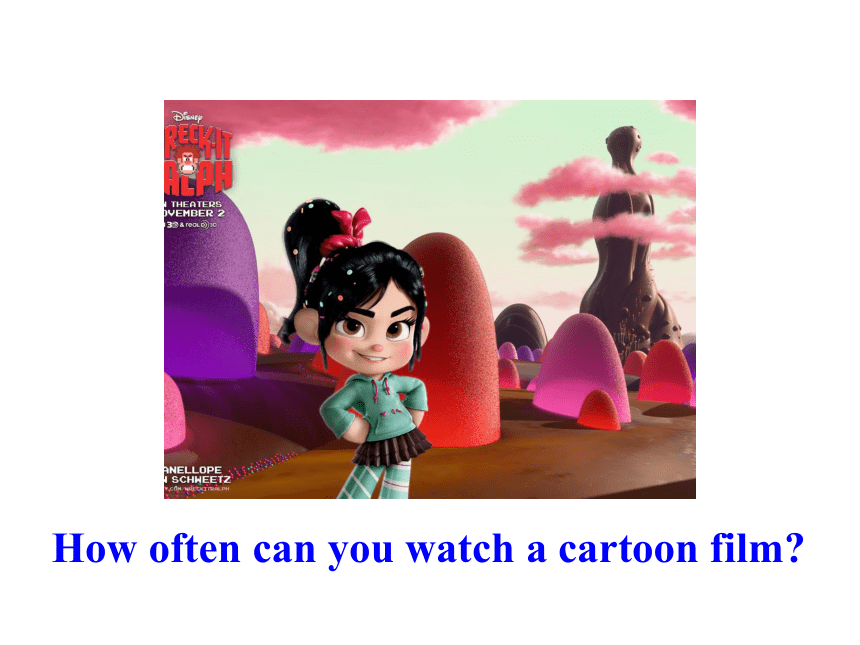

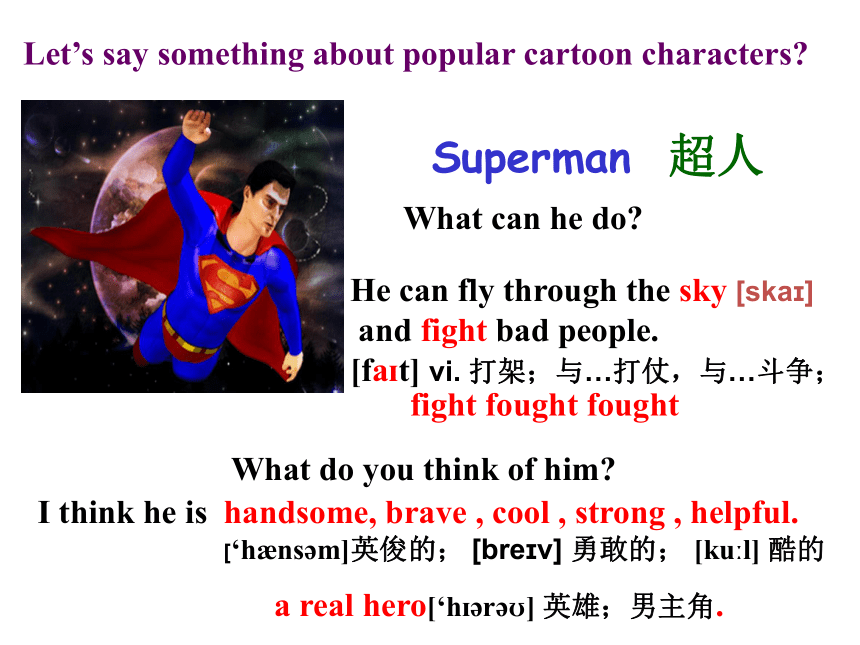
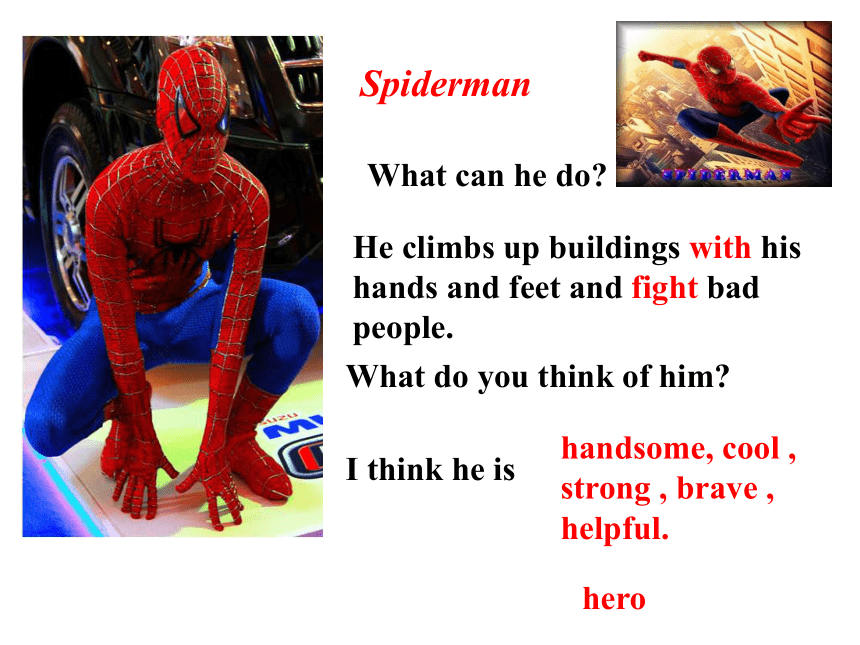

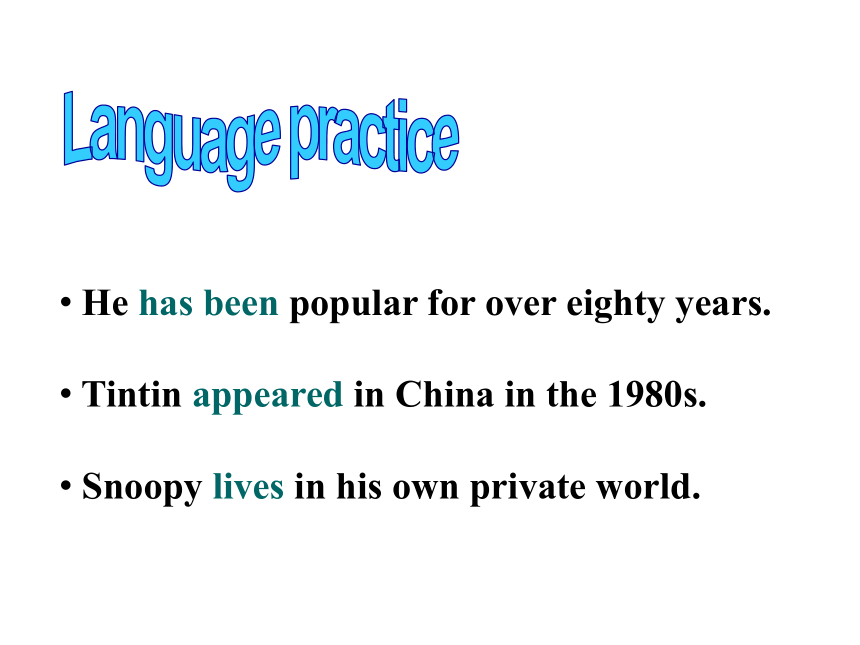
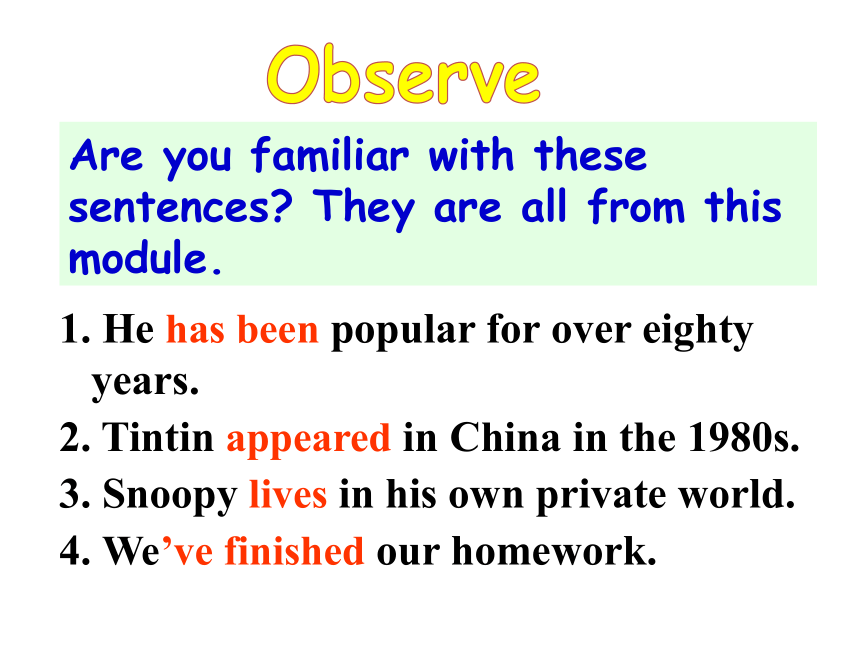
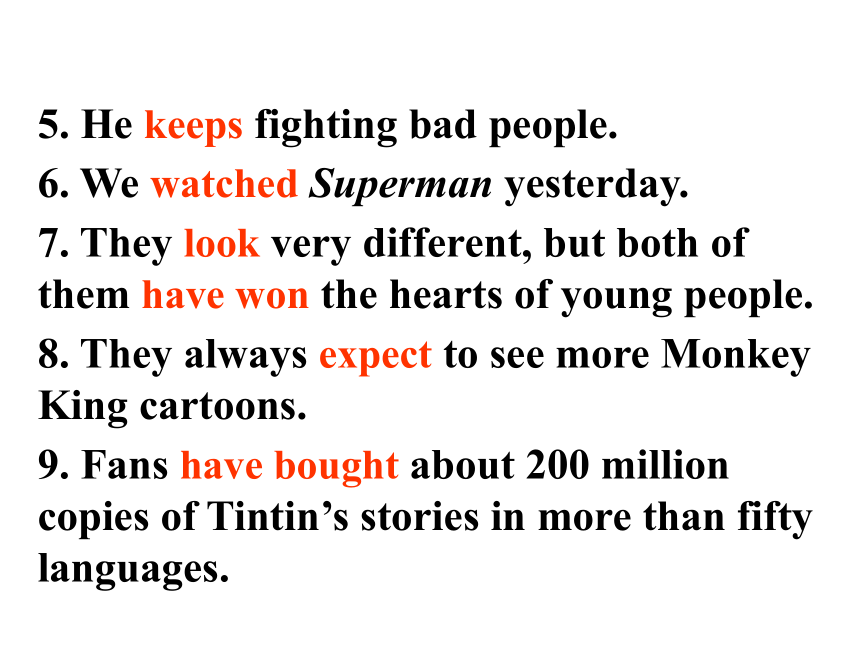
文档简介
课件69张PPT。Module 5
CartoonsUnit 3
Language in useDo you like watching cartoon films?Warming upDo you watch it at home or in the cinema?Do you go to watch a cartoon film with your family?How often can you watch a cartoon film?Tom and JerryWhat’s your favourite cartoon?My favourite cartoon isDoraemonLet’s say something about popular cartoon characters?Superman 超人 He can fly through the sky [ska?]
and fight bad people.
[fa?t] vi. 打架;与…打仗,与…斗争; fight fought foughtWhat do you think of him?I think he ishandsome, brave , cool , strong , helpful.
[‘h?ns?m]英俊的; [bre?v] 勇敢的; [ku?l] 酷的What can he do?a real hero[‘h??r??] 英雄;男主角.SpidermanWhat can he do?He climbs up buildings with his hands and feet and fight bad people.heroWhat do you think of him?I think he ishandsome, cool , strong , brave , helpful.Tom and JerryWhat do you think of Tom?It is humorous and funny.
['hju?m?r?s] adj. 诙谐的,幽默的 I think he is stupid.What do you think of Jerry?I think he is smart and cute.
[smɑ?t] 聪明的;机灵的I can’t help laughing when I watch them.can’t help doing sth禁止做某事laugh笑,发笑love each other He has been popular for over eighty years.
Tintin appeared in China in the 1980s.
Snoopy lives in his own private world.Language practiceObserveAre you familiar with these sentences? They are all from this module.1. He has been popular for over eighty years.
2. Tintin appeared in China in the 1980s.
3. Snoopy lives in his own private world.
4. We’ve finished our homework.5. He keeps fighting bad people.
6. We watched Superman yesterday.
7. They look very different, but both of them have won the hearts of young people.
8. They always expect to see more Monkey King cartoons.
9. Fans have bought about 200 million copies of Tintin’s stories in more than fifty languages.1. He _________ (be) popular for over eighty years.
2. Tintin ________ (appear) in China in the 1980s.
3. Snoopy _________ (live) in his own private world.
4.We ___________ (finish) our homework.
5. He __________ (keep) fighting bad people. has beenappeared lives have finished keeps6. We _________ (watch) Superman yesterday.
7. They ________ (look) very different, but both of them __________ (win) the hearts of young people.
8. They always _________ (expect) to see more Monkey King cartoons.
9. Fans ___________ (buy) about 200 million copies of Tintin’s stories in more than fifty languages.watched look have won expect have bought 几种时态的区分到目前为止,我们己经学过用多种时态来表达行为或状态。本模块重点复习一般现在时、一般过去时和现在完成时。那么,如何区分这三种时态呢?下面我们以一种行为或状 态为例,来看一下它们有什么不同。
请看下面的句子:
I often watch cartoon films.我经常看卡通片。
I watched Spiderman last week.
我上周看了《蜘蛛侠》。GrammarI have already watched Spiderman. I do not want to watch it again.
我已经看过《蜘蛛侠》了,不想再看了。
可以看出,(1)表示经常性、习惯性的动作,所以用一般现在时;(2)表示在过去某个时间发生的行为,用一般过去时;(3)中发生的动作也是在过去,但是没有明确的表 示过去的时间,并且本句强调的是结果,即“现在不想再看了”,所以用的是现在完成时。1.表示经常或反复发生的动作,常与 always, often, usually, sometimes,once a day, every day等频度时间状语连用。如:
He often goes to school by bus.
他经常坐公交车上学。
We always have supper at 6:30 pm.
我们总是在晚上6点半吃晚饭。一般现在时的用法2. 表示现在的状态、特征、能力和感觉。这类动词有be, love,like,hate, want, hope, need, prefer, wish, know, look, sound, taste, have 等。.如:
He is very happy.他很幸福。(表示状态)
She looks like her father.
她看上去像她爸爸。(表示特征)
He knows not only English, but also French.
他不仅懂英语,而且懂法语。(表示能力) How do you like the film?
你觉得这个电影怎么样?(表示感觉)3. 表示客观真理、科学事实和客观存在。如:
The sun rises in the east.
太阳从东方升起。
Light travels faster than sound.
光速比声速快。4.表示天气、时间、旅程、籍贯等情况。如:
—What’s the weather like today?
今天天气如何?
— It’s windy.今天有风。
—Where are you from?你是哪里人?
—I’m from Shanghai.我是上海人。?在时间状语从句和条件状语从句中,用一般现在时表示将来。如:
If it rains tomorrow, we’ll stay at home.
如果明天下雨,我们就呆在家里。
We won’t begin the class until our teacher arrives.
直到老师来,我们才开始上课。特别提示:?表示已决定或计划要做的事,或按自然规律会发生的事。常用于这类情况的动词有 come, go, start, begin, leave, return, arrive,stop, close 等,此时用一般现在时表示将来。如:
Her father leaves for America next week.
她父亲下周动身去美国。
When does the train arrive? 火车儿点到?
Tomorrow is Tuesday. 明天是星期二.一般过去时的用法1. 表示过去某一时间发生的动作或存在的状态,常与表示过去的时间状语连用,如 yesterday, last year/month/week, in 2004, three hours ago, two years ago 等。.如:
We helped the farmers with the apple-picking last year.
去年我们性帮农民摘过苹果。
The children enjoyed themselves yesterday.孩子们咋天玩得很高兴。
I finished my homework just now.
我刚刚与完了作业。2. 表示过去经常或反复发生的动作,也可以用used to do表示,常和often, always等 表示频度
的时间状语连用。如:
Tom often went to work by bus last year.
去年汤姆常常坐公交车去上班。
My father used to smoke.
我父亲过去常常抽烟。
He was always ready to help the people in trouble.
他时刻准备着帮助有困难的人。3. 有时动作发生的时间不是很清楚,但确实是过去发生的,应当用一般过去时。如:
Who broke the teapot?
谁打碎了茶壶?
Hi, Lucy! I didn't know you were here.
嗨,露西!我不知道你在这儿。4. 在时间或条件状语从句中,用一般过去时表示“过去将来的”动作。如:
He would let me know if he got information.
他一得到信息就会让我知道。
The man jumped off the train as soon as it stopped.
火车一停,这个人就跳了下来。
He promised to buy me a dress when he went abroad the next week.
他许诺下周出国时 给我买条连衣裙。1.强调过去的动作对现在的影响,往往具有因果关系,常与already, yet等副词 连用。如:
She has already bought a computer.
她已经买了 电脑。
He has not found a job yet.
他还没有找到工作。
The Greens have gone to England.
格林一家已经去了英国。现在完成时的用法2.表示过去某一动作一直持续至今,常与for, since等引导的时间状语连用。如:
I have been in Beijing for five years.
我已经在北呆了 5 年了。
He has lived here since he moved here.
从他搬到这儿以来就一直住在这里。3.表示经历或经验,常与ever, never, once,twice, before等副词连用。如:
—Have you ever been to Shanghai?
你去过上海吗?
—I have been there twice.
我去过那里两次了。特别提示: have (has) been to 与 have (has) gone to 的区别
have (has) been to表示“去过,到过”某个地方,但现在人已不在那里,常与ever, never, often, once, twice 等连用:have (has) gone to 意思是“去了”,人可能在途中或已经在那里。如:
Have you ever been to Shanghai?
你去过上海吗?(人不在上海)
He has gone to Shanghai.他已经去上海了。
(人在上海或在去上海的途中) for与since的区别
for表示“经过多久”,多与完成时连用,后接时间段。如:
She has stayed here for half an hour.
她已经在这儿采了半个小时了。
since表示从过去某一时间一直到现在,并仍在继续。如:
Mr Li has kept this painting since 1950.
自1950年以来,李先生一直保存着这幅画。当句子的时间状语是“for + 一段时间”或使用how long对肯定句提问时,不能使用短暂性动词,因为短暂性动词不能持续,也就不能和表示一段时间的状语连用。遇到短暂性动词要把它变成相应的延续性动词。如:
Tom borrowed the book a week ago.
— Tom has kept the book for a week.常见的短暂性动词和延续性动词的对应表如下:1. 现在完成时和一般过去时都表示在过去完成的动作。但现在完成时强调的这?一动作与现在的关系。如对现在产生的结果或影响等,而一般过去时只表示动作在过去某一时刻发生,不表示和现在的关系。试比较:
?a.?I?have?lost?my?new?book.???
??? 我把新书丢了。(现在还未找到)??
b.?I?lost?my?new?book?yesterday.??
我昨天把新书丢了。(昨天丢的,现在找到与否没说明。)现在完成时与一般过去时的区别:2. 侧重点不同。现在完成时侧重于现在的结果,而一般过去时侧重于动作发生的时间。?
?a.?I?have?seen?the?film.????
我看过这部电影。(现在我仍记得电影的内容)??
I?saw?the?film?three?days?ago.?
?三天前我看了这部电影。?(强调是三天前,而不是别的什么时候看的电影)??
b.?He?has?been?in?the?League?for?three?years.????
他入团已经三年了。?
c.?Tom?wrote?a?letter?to?his?parents?last?night.???? 昨晚汤姆给他的父母写了封信。3.?两种时态的区分?
?(1)一般过去时的谓语动词用过去式,而现在完成时的谓语基本构成是“助动词 have?/has?+过去分词”。
?(2)?时间状语不同。一般过去时则常与yesterday,?just?now,?in?2002,“段时间+ago”, “last+段时间”等表示过去时间的状语连用;
而现在完成时则常与just, already, yet, ?ever,
?never,?before等副词以及和these?days,?
this?week,?“for+段时间”,“since+过去时间/从句”或“since+过去时间+ago”等时间状语连用。 Grammar一般过去时常犯错误
1. 把动词变为过去式易出错。
例如:They stoped talking just now.
解析:stop的过去时为stopped。辅音加y,y变i加ed;元音加y,在词尾直接加ed。2. 忘记把动词变为过去式。
例如:I fly kites on the afternoon of last Sunday.
解析:fly应该用过去式flew。对此,我们应该记住在一般过去时的时态里,过去式不要忘记。3. 在句式变换时出错。
例如:We didn’t went last Friday.
解析:didn’t went应改为didn’t go。
请记住“见助动词用原形”。4. 易与现在完成时弄混。
例如:I saw the film, so I don’t want to go now.
解析:正确答案为:I have seen the film, so I don’t want to go now.“我不想去”说明了我了解这部影片的内容,强调现在的情况,应该用现在完成时。Daming: Hi. Tony. What are you reading?
Tony: The Adventures of Tintin. It's fantastic.
(1)_____ you __________ (ever read) a
Tintin book?
Daming: No, I (2) _______________ (never read)
a Tintin story. (3) _____ (be) they
popular?
Tony: Yes, they (4) __________ (be) popular1. Complete the conversation with the correct form of the words in brackets.Have ever readhave never readArehave been for more than eighty years. The first
Tintin story (5)_________ (appear) in
1929.
Daming: What does Tintin do?
Tony: He (6)_______ (work) for a newspaper
and he (7) ____ (have) lots of exciting
experiences.
Daming: And (8)____the stories _____(have)
happy endings?
Tony: Oh, yes, they always do.
Daming: Sounds great! Do you mind if I borrow
your book?appearedworkshas do have When I was young, I (1) __________(not like) green vegetables. The only vegetable I (2) ____ (eat) was potatoes. I was quite small and not very strong, so I was not very good at sport. Then when I (3) _____________ (watch) television one day I saw the cartoon Popeye. 2. Complete the passage with the correct form of the words in brackets.did not likeatewas watchingWhen Popeye stands next to the bad man.
Bluto, he (4) ______ (look) small and weak, and when they fight, he always (5)_____ (lose). Then he eats some green vegetables. His arms (6)
______ (grow) thicker. He becomes stronger and he wins his fights. The next day I was going to play football at school, so I asked my mother for some green vegetables. I (7)_______ (score) three times and we won the match! I (8)
_________ (love) green vegetables ever since.lookslosesgrowscoredhave loved3. Complete the passage with the words in the box.create laugh mess own private satisfy ugly Many people love cartoons because they are great fun. Parents and children (1) _______ together as the Monkey King makes a terrible
(2) _____ or Shrek, the (3) ____ green man, laughmessuglysings a song. Cartoon heroes often live in a(n) (4) _______ world of their (5) _____. Artists (6) _______ good cartoon heroes as well as bad people . The heroes always win, and their stories (7) _______ us and help us feel safe.privateowncreatesatisfyWhen you are listening, do not stop paying attention when you hear a word you do not know. Keep listening. The word might not be important, or the speaker may say something to explain its meaning.Learning to learnTony: (laughing) I think this is really funny!
Betty: Why? I don't get the joke.
Tony: Look! In the first picture, there's a
man running away from a policeman.
Betty: But why is he running away? I don't
understand.
Tony: Well, he's done something wrong! The
policeman wants to catch him.TapescriptBetty: I see. And then the man runs into the lift.
Tony: Yes, and this is the funny bit. It's really
clever! The policeman could catch the
man in the lift, but he doesn't. They both
just stand there, waiting for the lift to
stop!
Betty: Now I get it! Yes, it is funny!
Tony: Yes, and as we see in the last picture, the
policeman is still trying to catch the man!6. Read the passage and complete the sentences. The first cartoons appeared in newspaper. They told stories using pictures. The first photographed cartoon film (in 1906) was about humorous faces. In the film, an artist drew pictures of two faces on a blackboard. The laces came lo life. They smiled and a small dog jumped through a ring. There were a lot of animals in early cartoons. One famous early cartoon character was Felix the Cat.
Walt Disney started to make films in the 1920s. Some of his earliest films were about a famous story, Alice in Wonderland, but in Disney's films it was called Alice in Cartoon Land. Walt Disney's most famous cartoon character was Mickey Mouse. He appeared in1928, first in a black-and-white film without sound, then very soon after that in a talking film and later in colour. A Mickey Mouse film was the first cartoon film with sound to become really popular.
Today, over a hundred years later, cartoons are still popular with people of all ages. They will probably be popular for many more years in the future. 1960 1.The first cartoon film
was about _____________.
2. In the film, the faces _________. They______.
3. A small dog _______
______________.humorous facescame to lifesmiledjumpedthrough a ring1920s4. Walt Disneystarted to _________in the 1920.make film5. A Mickey Mouse film wasthe first cartoon film ____
_____ to become reallywithsound popular. Today and in the future6. Cartoon films are still popular with________________________.
7. They will probably be popular for__________ years in the future. children and older peoplemany more Batman and Spiderman are two of the most famous American cartoons. Batman is older than Spiderman. The first Batman cartoon appeared in 1939. Batman is one of the fewClassic American cartoons:
Batman and Spidermanseen over 500 different newspapers around the world. People have also made films based on Batman and Spiderman.cartoon heroes to appear in books continuously since 1940.
Spiderman was created a lot later. He first appeared in 1962. In 1977 he appeared in daily newspapers. The Spiderman cartoons has beenModule task :7. Work in groups. Plan your cartoon. Making a cartoonTalk about your favourite cartoons and decide
on the kinds f cartoon hero you would like to
create.
Talk about developing the heroes. What are
they like? What do they look like? What do
they do? How will they win people’s hearts?
Decide who will write the story and who will do
the drawings.8. Make your cartoon. 9. Show your cartoon to your classmates. Plan your story. How many different pictures
will you need to tell the story?
Write the story first and decide how it will be
presented with the drawings.
Make some drawings. Use a computer, if you
like.
Put the finished drawings and the story
together and present them on large pieces of
paper.1. I often _____ my homework after supper.
A. do B. does
C. doing D. done
解析:此句表示经常发生的动作,often应该用于一般现在时,主语为第一人称,故选A。Exercise一、单项选择题。A2. —I wish your sister would come to visit me.
—I'll tell her when I ______ her.
A. see B. saw
C. will see D. am seeing
解析:在时间状语从句和条件状语从句中,用一般现在时表示将来。
3. The picture ___ very beautiful.
A. looking B. look
C. looks D. is looked
解析:表示特征时用一般现在时。AC4. Mother _____very busy. She often___ home very late.
A. is; come B. will be; comes
C. is; comes D. is; is coming
解析:前句表示现在的状态,后句表示经常发生的动作,都用一般现在时。
5. Food easily ______ bad in hot weather.
A. goes B. go C. went D. goes to
解析:表示科学事实时用一般现在时。go bad是固定词组,意为“变质,变坏”。CA6. — He has already gone to England.
—When ____ he _____ there?
A. will; go B. is; going
C. did; go D. has; gone
解析:由上下文可知,下句应问“他何时去的? ”,用一般过去时。
7. I _____ a story book from the library yesterday.
lend B. lent C. borrowed D. borrow
解析:从yesterday判断应用一般过去时。borrow...from表示“从……借来”,而lend…to表示“把……借给”。CC8. Mozart _____ more than 600 pieces of music.
wrote B. writes C. will write D. writed
解析:莫扎特是已经去世的音乐家,故应用一般过去时,而write属于不规则动词,过去式为wrote。
9. The last half of nineteenth century_____ the steady improvement in the means of travel.
A. has witnessed B. was witnessed
C. is witnessed D. witnessed
解析:由 the last half of nineteenth century 可知,应用一般过去时AD10 . He _____ stamps when he was young,but now there is nearly no stamp left.
used to collecting
B. used to collect
C. is used to collecting
D. is used to collect
解析:由题意“他年轻的时候常常集邮,可现在已经没剩下儿张邮票了”可知,用used to do sth.句型表示“过去常常做某事,而现在不做了”。B11. There ______a lot of changes here since 1980.
A. have been B. have had
C. will be D. are
解析:由时间状语since 1980可知,此句应用there be的现在完成时。
12. It _____ every day so far this week.
A. rains B. has rained
C. had rained D. will rain
解析: so far到目前为止”,与现在完成时连用。AB13. — ____ your uncle ______the videotapes
to Mr Fox?
—No. They are still in his bedroom.
A. Did; return B. Has; returned
C. Will; return D. Does; return
解析:由答语They are still in his bedroom可知,应用现在完成时。B 14. He _____ our school for two weeks.
A. left B. has left
C. has been away from D. is leaving
解析:由时间状语可知,要用现在完成时;而 leave是短暂性动词,不能和一段时间连用。C15. The Greens have _____ Honolulu for a few days.
A. been in B. worked at
C. left for D. gone to
解析:由for a few days可知,格林一家是在檀香山“呆” 了儿天,而不可能是“工作” 了儿天;leave, go是短暂性动词,不能和一段时间连用。AHomeworkSummarise and consolidate the use of the present perfect , present simple and past simple by yourself.
Try your best to master what you have learned in this module and preview the next module.
CartoonsUnit 3
Language in useDo you like watching cartoon films?Warming upDo you watch it at home or in the cinema?Do you go to watch a cartoon film with your family?How often can you watch a cartoon film?Tom and JerryWhat’s your favourite cartoon?My favourite cartoon isDoraemonLet’s say something about popular cartoon characters?Superman 超人 He can fly through the sky [ska?]
and fight bad people.
[fa?t] vi. 打架;与…打仗,与…斗争; fight fought foughtWhat do you think of him?I think he ishandsome, brave , cool , strong , helpful.
[‘h?ns?m]英俊的; [bre?v] 勇敢的; [ku?l] 酷的What can he do?a real hero[‘h??r??] 英雄;男主角.SpidermanWhat can he do?He climbs up buildings with his hands and feet and fight bad people.heroWhat do you think of him?I think he ishandsome, cool , strong , brave , helpful.Tom and JerryWhat do you think of Tom?It is humorous and funny.
['hju?m?r?s] adj. 诙谐的,幽默的 I think he is stupid.What do you think of Jerry?I think he is smart and cute.
[smɑ?t] 聪明的;机灵的I can’t help laughing when I watch them.can’t help doing sth禁止做某事laugh笑,发笑love each other He has been popular for over eighty years.
Tintin appeared in China in the 1980s.
Snoopy lives in his own private world.Language practiceObserveAre you familiar with these sentences? They are all from this module.1. He has been popular for over eighty years.
2. Tintin appeared in China in the 1980s.
3. Snoopy lives in his own private world.
4. We’ve finished our homework.5. He keeps fighting bad people.
6. We watched Superman yesterday.
7. They look very different, but both of them have won the hearts of young people.
8. They always expect to see more Monkey King cartoons.
9. Fans have bought about 200 million copies of Tintin’s stories in more than fifty languages.1. He _________ (be) popular for over eighty years.
2. Tintin ________ (appear) in China in the 1980s.
3. Snoopy _________ (live) in his own private world.
4.We ___________ (finish) our homework.
5. He __________ (keep) fighting bad people. has beenappeared lives have finished keeps6. We _________ (watch) Superman yesterday.
7. They ________ (look) very different, but both of them __________ (win) the hearts of young people.
8. They always _________ (expect) to see more Monkey King cartoons.
9. Fans ___________ (buy) about 200 million copies of Tintin’s stories in more than fifty languages.watched look have won expect have bought 几种时态的区分到目前为止,我们己经学过用多种时态来表达行为或状态。本模块重点复习一般现在时、一般过去时和现在完成时。那么,如何区分这三种时态呢?下面我们以一种行为或状 态为例,来看一下它们有什么不同。
请看下面的句子:
I often watch cartoon films.我经常看卡通片。
I watched Spiderman last week.
我上周看了《蜘蛛侠》。GrammarI have already watched Spiderman. I do not want to watch it again.
我已经看过《蜘蛛侠》了,不想再看了。
可以看出,(1)表示经常性、习惯性的动作,所以用一般现在时;(2)表示在过去某个时间发生的行为,用一般过去时;(3)中发生的动作也是在过去,但是没有明确的表 示过去的时间,并且本句强调的是结果,即“现在不想再看了”,所以用的是现在完成时。1.表示经常或反复发生的动作,常与 always, often, usually, sometimes,once a day, every day等频度时间状语连用。如:
He often goes to school by bus.
他经常坐公交车上学。
We always have supper at 6:30 pm.
我们总是在晚上6点半吃晚饭。一般现在时的用法2. 表示现在的状态、特征、能力和感觉。这类动词有be, love,like,hate, want, hope, need, prefer, wish, know, look, sound, taste, have 等。.如:
He is very happy.他很幸福。(表示状态)
She looks like her father.
她看上去像她爸爸。(表示特征)
He knows not only English, but also French.
他不仅懂英语,而且懂法语。(表示能力) How do you like the film?
你觉得这个电影怎么样?(表示感觉)3. 表示客观真理、科学事实和客观存在。如:
The sun rises in the east.
太阳从东方升起。
Light travels faster than sound.
光速比声速快。4.表示天气、时间、旅程、籍贯等情况。如:
—What’s the weather like today?
今天天气如何?
— It’s windy.今天有风。
—Where are you from?你是哪里人?
—I’m from Shanghai.我是上海人。?在时间状语从句和条件状语从句中,用一般现在时表示将来。如:
If it rains tomorrow, we’ll stay at home.
如果明天下雨,我们就呆在家里。
We won’t begin the class until our teacher arrives.
直到老师来,我们才开始上课。特别提示:?表示已决定或计划要做的事,或按自然规律会发生的事。常用于这类情况的动词有 come, go, start, begin, leave, return, arrive,stop, close 等,此时用一般现在时表示将来。如:
Her father leaves for America next week.
她父亲下周动身去美国。
When does the train arrive? 火车儿点到?
Tomorrow is Tuesday. 明天是星期二.一般过去时的用法1. 表示过去某一时间发生的动作或存在的状态,常与表示过去的时间状语连用,如 yesterday, last year/month/week, in 2004, three hours ago, two years ago 等。.如:
We helped the farmers with the apple-picking last year.
去年我们性帮农民摘过苹果。
The children enjoyed themselves yesterday.孩子们咋天玩得很高兴。
I finished my homework just now.
我刚刚与完了作业。2. 表示过去经常或反复发生的动作,也可以用used to do表示,常和often, always等 表示频度
的时间状语连用。如:
Tom often went to work by bus last year.
去年汤姆常常坐公交车去上班。
My father used to smoke.
我父亲过去常常抽烟。
He was always ready to help the people in trouble.
他时刻准备着帮助有困难的人。3. 有时动作发生的时间不是很清楚,但确实是过去发生的,应当用一般过去时。如:
Who broke the teapot?
谁打碎了茶壶?
Hi, Lucy! I didn't know you were here.
嗨,露西!我不知道你在这儿。4. 在时间或条件状语从句中,用一般过去时表示“过去将来的”动作。如:
He would let me know if he got information.
他一得到信息就会让我知道。
The man jumped off the train as soon as it stopped.
火车一停,这个人就跳了下来。
He promised to buy me a dress when he went abroad the next week.
他许诺下周出国时 给我买条连衣裙。1.强调过去的动作对现在的影响,往往具有因果关系,常与already, yet等副词 连用。如:
She has already bought a computer.
她已经买了 电脑。
He has not found a job yet.
他还没有找到工作。
The Greens have gone to England.
格林一家已经去了英国。现在完成时的用法2.表示过去某一动作一直持续至今,常与for, since等引导的时间状语连用。如:
I have been in Beijing for five years.
我已经在北呆了 5 年了。
He has lived here since he moved here.
从他搬到这儿以来就一直住在这里。3.表示经历或经验,常与ever, never, once,twice, before等副词连用。如:
—Have you ever been to Shanghai?
你去过上海吗?
—I have been there twice.
我去过那里两次了。特别提示: have (has) been to 与 have (has) gone to 的区别
have (has) been to表示“去过,到过”某个地方,但现在人已不在那里,常与ever, never, often, once, twice 等连用:have (has) gone to 意思是“去了”,人可能在途中或已经在那里。如:
Have you ever been to Shanghai?
你去过上海吗?(人不在上海)
He has gone to Shanghai.他已经去上海了。
(人在上海或在去上海的途中) for与since的区别
for表示“经过多久”,多与完成时连用,后接时间段。如:
She has stayed here for half an hour.
她已经在这儿采了半个小时了。
since表示从过去某一时间一直到现在,并仍在继续。如:
Mr Li has kept this painting since 1950.
自1950年以来,李先生一直保存着这幅画。当句子的时间状语是“for + 一段时间”或使用how long对肯定句提问时,不能使用短暂性动词,因为短暂性动词不能持续,也就不能和表示一段时间的状语连用。遇到短暂性动词要把它变成相应的延续性动词。如:
Tom borrowed the book a week ago.
— Tom has kept the book for a week.常见的短暂性动词和延续性动词的对应表如下:1. 现在完成时和一般过去时都表示在过去完成的动作。但现在完成时强调的这?一动作与现在的关系。如对现在产生的结果或影响等,而一般过去时只表示动作在过去某一时刻发生,不表示和现在的关系。试比较:
?a.?I?have?lost?my?new?book.???
??? 我把新书丢了。(现在还未找到)??
b.?I?lost?my?new?book?yesterday.??
我昨天把新书丢了。(昨天丢的,现在找到与否没说明。)现在完成时与一般过去时的区别:2. 侧重点不同。现在完成时侧重于现在的结果,而一般过去时侧重于动作发生的时间。?
?a.?I?have?seen?the?film.????
我看过这部电影。(现在我仍记得电影的内容)??
I?saw?the?film?three?days?ago.?
?三天前我看了这部电影。?(强调是三天前,而不是别的什么时候看的电影)??
b.?He?has?been?in?the?League?for?three?years.????
他入团已经三年了。?
c.?Tom?wrote?a?letter?to?his?parents?last?night.???? 昨晚汤姆给他的父母写了封信。3.?两种时态的区分?
?(1)一般过去时的谓语动词用过去式,而现在完成时的谓语基本构成是“助动词 have?/has?+过去分词”。
?(2)?时间状语不同。一般过去时则常与yesterday,?just?now,?in?2002,“段时间+ago”, “last+段时间”等表示过去时间的状语连用;
而现在完成时则常与just, already, yet, ?ever,
?never,?before等副词以及和these?days,?
this?week,?“for+段时间”,“since+过去时间/从句”或“since+过去时间+ago”等时间状语连用。 Grammar一般过去时常犯错误
1. 把动词变为过去式易出错。
例如:They stoped talking just now.
解析:stop的过去时为stopped。辅音加y,y变i加ed;元音加y,在词尾直接加ed。2. 忘记把动词变为过去式。
例如:I fly kites on the afternoon of last Sunday.
解析:fly应该用过去式flew。对此,我们应该记住在一般过去时的时态里,过去式不要忘记。3. 在句式变换时出错。
例如:We didn’t went last Friday.
解析:didn’t went应改为didn’t go。
请记住“见助动词用原形”。4. 易与现在完成时弄混。
例如:I saw the film, so I don’t want to go now.
解析:正确答案为:I have seen the film, so I don’t want to go now.“我不想去”说明了我了解这部影片的内容,强调现在的情况,应该用现在完成时。Daming: Hi. Tony. What are you reading?
Tony: The Adventures of Tintin. It's fantastic.
(1)_____ you __________ (ever read) a
Tintin book?
Daming: No, I (2) _______________ (never read)
a Tintin story. (3) _____ (be) they
popular?
Tony: Yes, they (4) __________ (be) popular1. Complete the conversation with the correct form of the words in brackets.Have ever readhave never readArehave been for more than eighty years. The first
Tintin story (5)_________ (appear) in
1929.
Daming: What does Tintin do?
Tony: He (6)_______ (work) for a newspaper
and he (7) ____ (have) lots of exciting
experiences.
Daming: And (8)____the stories _____(have)
happy endings?
Tony: Oh, yes, they always do.
Daming: Sounds great! Do you mind if I borrow
your book?appearedworkshas do have When I was young, I (1) __________(not like) green vegetables. The only vegetable I (2) ____ (eat) was potatoes. I was quite small and not very strong, so I was not very good at sport. Then when I (3) _____________ (watch) television one day I saw the cartoon Popeye. 2. Complete the passage with the correct form of the words in brackets.did not likeatewas watchingWhen Popeye stands next to the bad man.
Bluto, he (4) ______ (look) small and weak, and when they fight, he always (5)_____ (lose). Then he eats some green vegetables. His arms (6)
______ (grow) thicker. He becomes stronger and he wins his fights. The next day I was going to play football at school, so I asked my mother for some green vegetables. I (7)_______ (score) three times and we won the match! I (8)
_________ (love) green vegetables ever since.lookslosesgrowscoredhave loved3. Complete the passage with the words in the box.create laugh mess own private satisfy ugly Many people love cartoons because they are great fun. Parents and children (1) _______ together as the Monkey King makes a terrible
(2) _____ or Shrek, the (3) ____ green man, laughmessuglysings a song. Cartoon heroes often live in a(n) (4) _______ world of their (5) _____. Artists (6) _______ good cartoon heroes as well as bad people . The heroes always win, and their stories (7) _______ us and help us feel safe.privateowncreatesatisfyWhen you are listening, do not stop paying attention when you hear a word you do not know. Keep listening. The word might not be important, or the speaker may say something to explain its meaning.Learning to learnTony: (laughing) I think this is really funny!
Betty: Why? I don't get the joke.
Tony: Look! In the first picture, there's a
man running away from a policeman.
Betty: But why is he running away? I don't
understand.
Tony: Well, he's done something wrong! The
policeman wants to catch him.TapescriptBetty: I see. And then the man runs into the lift.
Tony: Yes, and this is the funny bit. It's really
clever! The policeman could catch the
man in the lift, but he doesn't. They both
just stand there, waiting for the lift to
stop!
Betty: Now I get it! Yes, it is funny!
Tony: Yes, and as we see in the last picture, the
policeman is still trying to catch the man!6. Read the passage and complete the sentences. The first cartoons appeared in newspaper. They told stories using pictures. The first photographed cartoon film (in 1906) was about humorous faces. In the film, an artist drew pictures of two faces on a blackboard. The laces came lo life. They smiled and a small dog jumped through a ring. There were a lot of animals in early cartoons. One famous early cartoon character was Felix the Cat.
Walt Disney started to make films in the 1920s. Some of his earliest films were about a famous story, Alice in Wonderland, but in Disney's films it was called Alice in Cartoon Land. Walt Disney's most famous cartoon character was Mickey Mouse. He appeared in1928, first in a black-and-white film without sound, then very soon after that in a talking film and later in colour. A Mickey Mouse film was the first cartoon film with sound to become really popular.
Today, over a hundred years later, cartoons are still popular with people of all ages. They will probably be popular for many more years in the future. 1960 1.The first cartoon film
was about _____________.
2. In the film, the faces _________. They______.
3. A small dog _______
______________.humorous facescame to lifesmiledjumpedthrough a ring1920s4. Walt Disneystarted to _________in the 1920.make film5. A Mickey Mouse film wasthe first cartoon film ____
_____ to become reallywithsound popular. Today and in the future6. Cartoon films are still popular with________________________.
7. They will probably be popular for__________ years in the future. children and older peoplemany more Batman and Spiderman are two of the most famous American cartoons. Batman is older than Spiderman. The first Batman cartoon appeared in 1939. Batman is one of the fewClassic American cartoons:
Batman and Spidermanseen over 500 different newspapers around the world. People have also made films based on Batman and Spiderman.cartoon heroes to appear in books continuously since 1940.
Spiderman was created a lot later. He first appeared in 1962. In 1977 he appeared in daily newspapers. The Spiderman cartoons has beenModule task :7. Work in groups. Plan your cartoon. Making a cartoonTalk about your favourite cartoons and decide
on the kinds f cartoon hero you would like to
create.
Talk about developing the heroes. What are
they like? What do they look like? What do
they do? How will they win people’s hearts?
Decide who will write the story and who will do
the drawings.8. Make your cartoon. 9. Show your cartoon to your classmates. Plan your story. How many different pictures
will you need to tell the story?
Write the story first and decide how it will be
presented with the drawings.
Make some drawings. Use a computer, if you
like.
Put the finished drawings and the story
together and present them on large pieces of
paper.1. I often _____ my homework after supper.
A. do B. does
C. doing D. done
解析:此句表示经常发生的动作,often应该用于一般现在时,主语为第一人称,故选A。Exercise一、单项选择题。A2. —I wish your sister would come to visit me.
—I'll tell her when I ______ her.
A. see B. saw
C. will see D. am seeing
解析:在时间状语从句和条件状语从句中,用一般现在时表示将来。
3. The picture ___ very beautiful.
A. looking B. look
C. looks D. is looked
解析:表示特征时用一般现在时。AC4. Mother _____very busy. She often___ home very late.
A. is; come B. will be; comes
C. is; comes D. is; is coming
解析:前句表示现在的状态,后句表示经常发生的动作,都用一般现在时。
5. Food easily ______ bad in hot weather.
A. goes B. go C. went D. goes to
解析:表示科学事实时用一般现在时。go bad是固定词组,意为“变质,变坏”。CA6. — He has already gone to England.
—When ____ he _____ there?
A. will; go B. is; going
C. did; go D. has; gone
解析:由上下文可知,下句应问“他何时去的? ”,用一般过去时。
7. I _____ a story book from the library yesterday.
lend B. lent C. borrowed D. borrow
解析:从yesterday判断应用一般过去时。borrow...from表示“从……借来”,而lend…to表示“把……借给”。CC8. Mozart _____ more than 600 pieces of music.
wrote B. writes C. will write D. writed
解析:莫扎特是已经去世的音乐家,故应用一般过去时,而write属于不规则动词,过去式为wrote。
9. The last half of nineteenth century_____ the steady improvement in the means of travel.
A. has witnessed B. was witnessed
C. is witnessed D. witnessed
解析:由 the last half of nineteenth century 可知,应用一般过去时AD10 . He _____ stamps when he was young,but now there is nearly no stamp left.
used to collecting
B. used to collect
C. is used to collecting
D. is used to collect
解析:由题意“他年轻的时候常常集邮,可现在已经没剩下儿张邮票了”可知,用used to do sth.句型表示“过去常常做某事,而现在不做了”。B11. There ______a lot of changes here since 1980.
A. have been B. have had
C. will be D. are
解析:由时间状语since 1980可知,此句应用there be的现在完成时。
12. It _____ every day so far this week.
A. rains B. has rained
C. had rained D. will rain
解析: so far到目前为止”,与现在完成时连用。AB13. — ____ your uncle ______the videotapes
to Mr Fox?
—No. They are still in his bedroom.
A. Did; return B. Has; returned
C. Will; return D. Does; return
解析:由答语They are still in his bedroom可知,应用现在完成时。B 14. He _____ our school for two weeks.
A. left B. has left
C. has been away from D. is leaving
解析:由时间状语可知,要用现在完成时;而 leave是短暂性动词,不能和一段时间连用。C15. The Greens have _____ Honolulu for a few days.
A. been in B. worked at
C. left for D. gone to
解析:由for a few days可知,格林一家是在檀香山“呆” 了儿天,而不可能是“工作” 了儿天;leave, go是短暂性动词,不能和一段时间连用。AHomeworkSummarise and consolidate the use of the present perfect , present simple and past simple by yourself.
Try your best to master what you have learned in this module and preview the next module.
同课章节目录
- Module 1 Feelings and impressions
- Unit 1 It smells delicious.
- Unit 2 I feel nervous when I speak Chinese .
- Unit 3 Language in use
- Module 2 Experiences
- Unit 1 I've also entered lots of speaking competi
- Unit 2 They have seen the Pyramids.
- Unit 3 Language in use
- Module 3 Journey to space
- Unit 1 Has it arrived yet?
- Unit 2 We have not found life on any other planet
- Unit 3 Language in use
- Module 4 Seeing the docto
- Unit 1 I haven't done much exercise since I got m
- Unit 2 We have played football for a year now
- Unit 3 Language in use
- Module 5 Cartoons
- Unit 1 It's time to watch a cartoon.
- Unit 2 Tintin has been popular for over eighty yea
- Unit 3 Language in use
- Revision module A
- Module 6 Hobbies
- Unit 1 Do you collect anything ?
- Unit 2 Hobbies can make you grow as a person.
- Unit 3 Language in use
- Module 7 Summer in Los Angeles
- Unit 1 Please write to me and send me some photos
- Unit 2 Fill out a form and come to learn English
- Unit 3 Language in use
- Module 8 Time off
- Unit 1 I can hardly believe we are in the city ce
- Unit 2 We thought somebody was moving about
- Unit 3 Language in use
- Module 9 Friendship
- Unit 1 Could I ask if you've mentioned this to he
- Unit 2 I believe that the world is what you think
- Unit 3 Language in use
- Module 10 On the radio
- Unit 1 I hope that you can join us one day
- Unit 2 It seemed that they were speaking to me in
- Unit 3 Language in use
- Revision module B
